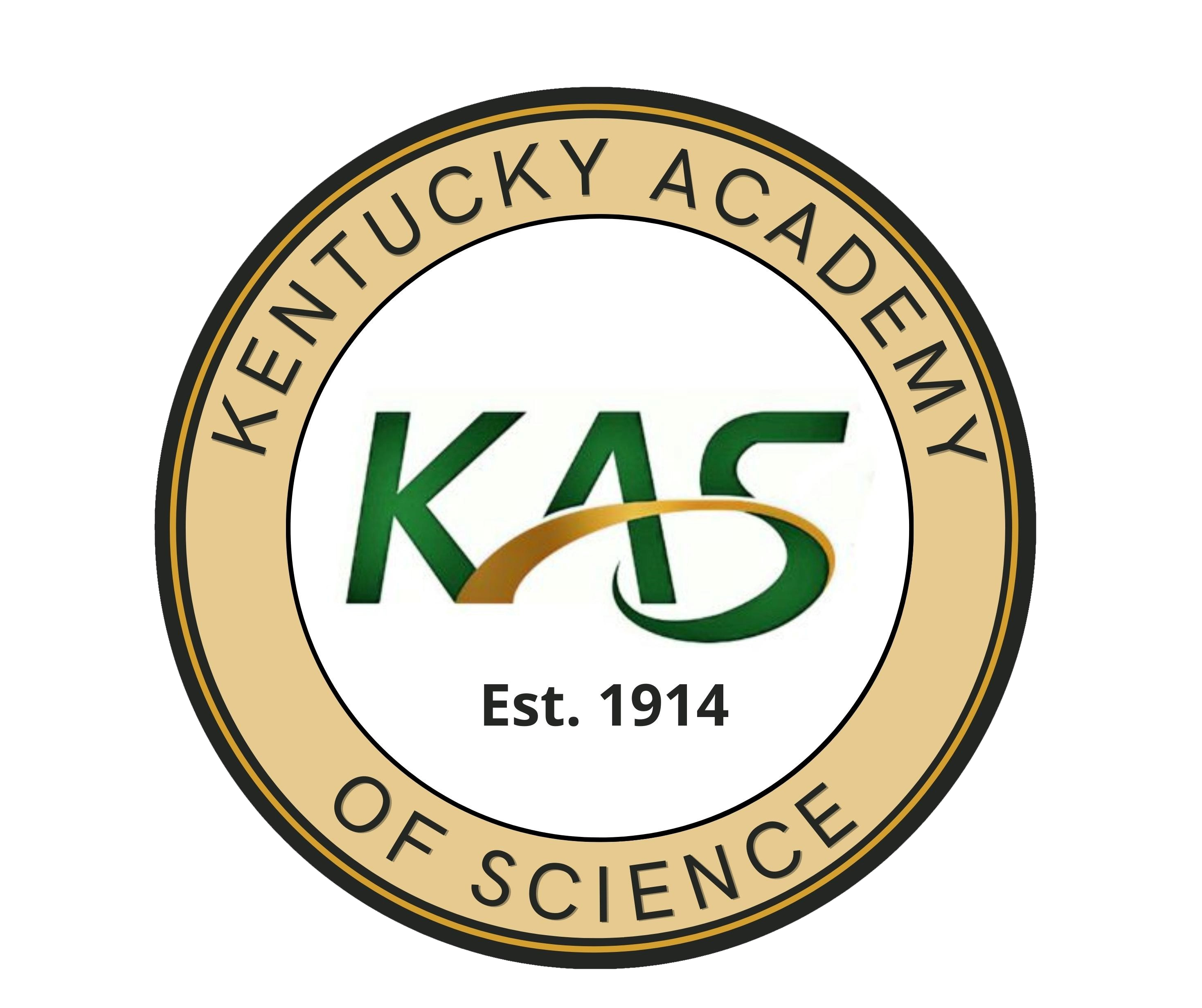Kentucky Academy of Science
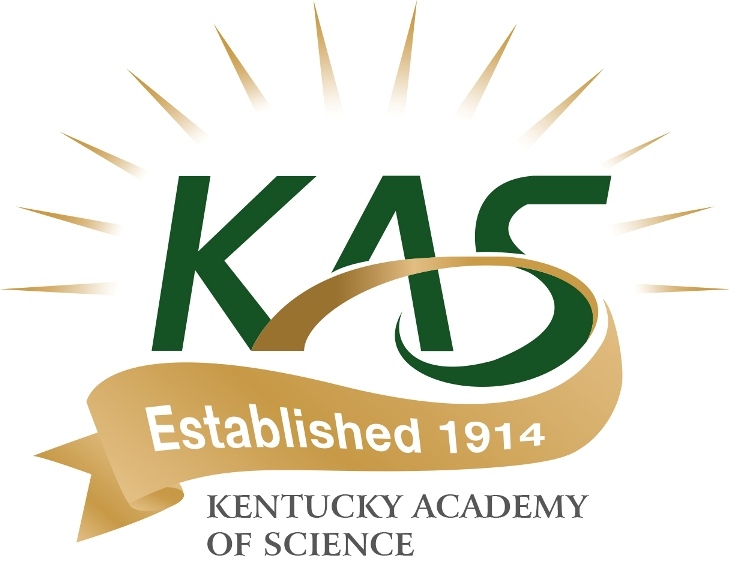
2019 Annual Meeting Program
November 1-2, 2019
Berea College
Welcome to the 105th Kentucky Academy of Science Annual Meeting at Berea College
Esteemed Kentucky science educators of the Kentucky Academy of Science.
Welcome back to Berea College for the first time since 1957. We are delighted to host the KAS 105th annual meeting. Thank you for your sustained and faithful support of scientific discovery and understanding throughout our great state.

Let me share a bit about our school. Berea College offers a high-quality education to academically promising students with limited economic resources. Founded in 1855, Berea was the first interracial and co-educational college in the South. Today, Berea is consistently ranked as one of the leading private liberal arts colleges in the USA, garnering much national attention and appreciation for its service to talented students who might not otherwise be able afford to attend college. To all 1,650 of our students we offer a 4-year no-tuition promise and a rigorous and high-quality education. Also, we don’t just admit students, we hire them. Every Berea student participates in our well-regarded Labor Program, which not only provides the College with a talented part-time work force, but also enables them to cover their other costs: room, books, and fees.
Another hallmark of Berea College is our very inclusive community, which warmly welcomes diversity in all of its forms. We are proud to be remaining faithful to our founder, abolitionist Rev. John Gregg Fee’s inspiring vision, expressed through the motto he chose (from the book of Acts) for our school, “God has made of one blood all peoples of the earth.”
We are also very proud of our programs and new facilities in the sciences. Our new Margaret A. Cargill Natural Sciences and Health Building, a 125,000 square foot, $72 million dollar facility, with a tissue-culture lab, vivarium, 500 MHz NMR, scanning electron microscope, high-fidelity Nursing simulation labs, optics lab, planetarium, and off-site greenhouse and observatory, houses our Biology, Chemistry, Geology, Mathematics, and Physics programs. Berea also has regular KAS participation from faculty and students in our Agriculture and Natural Resources, Psychology, Education, and Health and Human Performance Programs.
Again, welcome to Berea College. We trust you will enjoy the meeting and your visit.
Sincerely,
Dr. Lyle Roelofs
President, Berea College



Thank you to our Afternoon Break Sponsor

Thank you to our Business Meeting Luncheon Sponsor

Thank you to our Gold Level Sponsor

Thank you to our In-Kind partners

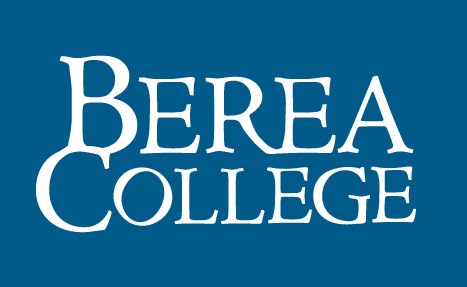
Thank you our Local Arrangements Team at Berea:
Dawn Anderson and Tracy Hodge
Thank you to our Program Coordinator
Melony Stambaugh
Thank you to Our 2019 Section Leaders
Agricultural Sciences
Shreya Patel, Kentucky State University, Chair
George Antonious, Kentucky State University, Secretary
Anthropology and Sociology
Benjamin Freed, Eastern Kentucky University, Chair
Cellular and Molecular Biology
Dena Weinberger, Murray State University, Chair
Chemistry: Analytical & Physical,
Jay Baltisberger, Berea College, Chair
Chemistry: Organic / Inorganic,
Yongming Deng, Western Kentucky University, Chair
Elizabeth Thomas, University of Pikeville, Secretary
Computer and Information Sciences
Jerzy Jaromczyk, University of Kentucky, Chair
Ecology,
Richard Boyce, Northern Kentucky University, Chair
Roberta Challener, Bellarmine University, Secretary
Environmental Science
Ben Brammell, Asbury University, Chair
Geography
Christopher Day, University of Louisville, Chair
Charlie Zhang, University of Louisville, Secretary
Geology
Patricia Kambesis, Western Kentucky University, Chair
Ann Harris, KCTCS, Secretary
Health Sciences
Avinash Tope, Kentucky State University, Chair
Lingyu Huang, Kentucky State University, Secretary
Mathematics
JustinTrulen, Kentucky Wesleyan College, Chair
Kyle Besing, Kentucky Wesleyan College, Secretary
Microbiology
Rachel Pritchard, Kentucky Wesleyan College, Chair
Physics and Astronomy
Thomas Jarvis, Eastern Kentucky University, Chair
Marilyn Akins, KCTCS, Secretary
Physiology and Biochemistry
Michael Guy, Northern Kentucky University, Chair
Tracy Livingston, Georgetown College, Chair
Psychology
Richard Osbaldiston, Eastern Kentucky University, Chair
Matthew Shake, Western Kentucky University, Secretary
Science Education
MelodyDanley, University of Kentucky, Chair
Kathryn Broadbent, KCTCS, Secretary
Zoology
Laura Sullivan Beckers, Murray State University, Chair
Roy Scudder-Davis, Berea College, Secretary
Thank you to Lumins Associates for Printed program design
KAS Annual Meeting Online Program, 2019
KAS Code of Conduct
The Kentucky Academy of Science Annual Meeting is an interdisciplinary professional environment that cultivates scientific discovery and understanding.
Thank you for contributing to our advancement of science by behaving professionally, respectfully and collegially at all times.
We want to make this meeting welcoming and accessible for you! Please let us know what you need.
Gender Neutral restrooms are available on MAC Science Building 5th floor
Mothers' Room is available on MAC Science Building 3rd floor
A Quiet room is available on the lower level of the MAC Science Building
Vans or other Transportation Assistance are available between buildings and to and from the parking areas.
Berea Campus map
 All are welcome to find out more about the Kentucky Organization of Field Stations, a network of researchers, land managers, and educators.
All are welcome to find out more about the Kentucky Organization of Field Stations, a network of researchers, land managers, and educators.In this work, I prove that Neptune is responsible for the instability by causing the Uranian Trojans to leak out of tadpole orbits into more unstable horseshoe orbits.
[1] A Private Universe, A video documentary on education research for grade 5-12 educators, produced by the Harvard-Smithsonian Center for Astrophysics. 1987.
[2] R. Lindell, Measuring Conceptual Change in College Students' Understanding of Lunar Phases, presented at the Physics Education Research Conference 2004, Sacramento, California, 2004.
Participants (N=103) from an individualistic culture (United Stated) and from a collectivistic culture (Republic of Indonesia) were given a set of questionnaires to assess their risk aversion. Participants were asked to make decisions under two conditions: one where others were impacted by their decision and the other where the decision did not impact anyone but themselves. A 2x2 mixed ANOVA was performed indicating that Indonesians are more risk-averse in general, regardless of who is impacted. Therefore, one must be aware that some cultures could be more or less risk-averse than others, especially when working with individuals from different backgrounds.
Devonian-Mississippian black-shale units formed due to foreland-basin subsidence and deformational loading associated with Acadian Orogeny, representing a north-to-south, transpressive collision between the southeastern margin of Laurussia and Avalonian terranes, allowing Devonian black-shale basins to migrate southwestward in time. However, by earliest Mississippian time, Sunbury-Riddlesburg basin migration shifted abruptly to the east with the inception of the Neoacadian Orogeny, which represents initial collision of the exotic Carolina terrane with the New York promontory and the southwestward, transpressional migration of orogeny. In response, the initial Sunbury-Riddlesburg basin formed just cratonward of the orogen at areas behind the New York promontory and expanded southwardly accompanying dextral transpression in the orogen. The overlying Price-Pocono-Borden-Grainger clastic units represent an extensive subaerial (Price and Pocono) and subaqueous (Grainger and Borden) delta complex that developed during erosion of Neoacadian highlands at both the New York and Virginia promontories.
We measured 81 meters of stratigraphic section using a Jacob's staff and sampled pertinent rock units for a reference collection at the KGS Earth Analysis Research Laboratory (EARL). The stratigraphic section shows several coarsening-upward sequences from 6 to 20 meters in thickness, capped by coal and/or organic-rich shale only about a decimeter thick. Clastic lithologies are not bioturbated but pervasively exhibit lamination in mudrocks and fine cross-lamination in siltstones and sandstones. A 40-cm thick sandstone unit showed water escape structures such as convolute lamination, capped by a bed with tabular crossbeds. Woody fragments and plant material are common in several units. Lithologies and sedimentary structures are consistent with shallow-water marine shale (prodelta?) overlain by sandstones (deltaic), in turn capped by coal and/or organic-rich mudstone that formed in coastal, freshwater swamps.
Ultimately: contextual information, lithologic descriptions, the measured stratigraphic column, and photographs of key features and samples will be posted on the KGS website as a story map. Samples will be archived at the KGS EARL.
We examine paleosols from the Erole, Kilaitoli, and Odele drainages within Gona. The Odele paleosol is between the Korina Tuff (<39 ka) and the Kilaitoli Tuff (~25.7 ka), while the Erole and Kilaitoli paleosols are above the Kilaitoli Tuff and immediately above a calibrated 14C age of 12 ka. Strain calculations show more volumetric collapse at Erole (39 ± 8 %) than at Odele (-5 ± 4 %). The open-system mass-transfer coefficient, tau, shows a 25 ± 13 % loss of SiO2 and a 71 ± 6 % loss of CaO at Erole, which are greater than the 8 ± 4 % loss of SiO2 and 7 ± 3 % loss of CaO at Odele, suggesting more weathering and vegetation leading to bioturbation during the AHP. Micromorphological analysis of thin sections from Kilaitoli are consistent with these calculations and show a microstructure and phytoliths common in grassland soils. The results of this study suggest wetter conditions during the AHP that facilitated the development of grasslands along tributary valleys.
We conducted an observational study of floral phenology in 18 prairie restorations in Louisville, Kentucky. Louisville is one of the worst urban heat islands in the US, where urban temperatures average 5°C warmer than rural regions. We hypothesized that urban sites would have earlier and shorter flowering durations, as shown in other manipulative warming experiments. However, this hypothesis was not supported. Land usage did not influence floral phenology in our system. We instead found that floral phenology was heavily influenced by soil parameters. Sites where soils harbored denser networks of mycorrhizal hyphae, and increased water holding capacity had significantly longer floral duration than sites with low mycorrhizae and water holding capacity.
Creation of this lecture material was done through the use of a lightboard, an internally lit pane of glass. The lightboard allows for online content to be presented in a way that is familiar to both the students and the instructor. In this talk, I will describe the specifics of the construction, including cost savings due to the use of open-source software.
This flipped classroom approach is currently being piloted in two sections of a general education probability and statistics class. I will discuss the current format of this course as well as initial observations.
and why the disagreement?
The United States and many other countries are facing a shortage of secondary school teachers, particularly in disciplines like science, technology, engineering and mathematics (STEM). The purpose of this study was to describe the perception of STEM majors about teaching as a career. The researchers used a mixed method approach to describe this perception. The quantitative findings emerged from the participants' completion of a version of the "Factors Influencing Teaching Choice" questionnaire. The qualitative findings emerged from interview data, a structured protocol where participants shared their views about personal and community perceptions about teaching, their experiences interacting with STEM teachers, and their views about the MSUTeach and MAT programs, options that allow for a STEM degree and a teacher certification. The findings of this study can be used to inform efforts to minimize STEM students' misconceptions about teaching as a career and to recruit pre-service STEM teachers more successfully.
The need for natural fumigants has increased due to the national prevention of synthetic soil fumigants, such as methyl bromide. In Brassica vegetables, biofumigation is the integration of plant residues that release isothiocyanates (ITCs) upon hydrolysis of glucosinolates (GSLs) into the soil as they decompose. Mixing Brassica dry or fresh plant tissues into agricultural soil defeats soil-borne pests and diseases owing to the release of ITCs, the most effective product of GSLs hydrolysis. We investigated the impact of soil amendments: sewage sludge (SS), horse manure (HM), chicken manure (CM), vermicompost (worm castings), commercial inorganic fertilizer, commercial organic fertilizer, and native bare soil on the concentration of GSLs in field grown turnip (Brassica rapa var. PTWG) root and shoot. GSLs, separated by adsorption on a diethyl amino-ethyl ether ion exchange resin, were quantified by measurement of enzymatically released glucose upon hydrolysis of GSLs by thioglucosidase. Results revealed that total GSLs concentrations were 4005 and 440 µM g-1 in turnip shoots and roots, respectively indicating 9 times more GSLs concentration in the shoots compared to the roots on fresh weight basis. Turnip plants grown in soil mixed with SS contained 2971 µM GSLs g-1 compared to plants grown in no-mulch bare soil (1350 µM g-1 fresh weight, which represents 55% increase in GSLs concentration. This increase in GSLs concentration revealed that turnip plants grown in soil amended with SS could play a significant role in controlling soil-borne diseases in conventional and organic agriculture as alternative to the use of synthetic soil fumigants.
Decision support systems involve the extraction of relevant information to be used for decision making in the operation of agriculture and managed land areas from a multitude of sources, including unmanned aerial systems. Using the Python programming language and web framework Django, an application was created for connecting farmers to an automated analysis form for processing single, uploaded images from personal drone devices. Drone images are uploaded to the web application to use for analysis, extraction of meta-data, and geo-referencing. The site also contains a file repository for sharing information and can be tagged by topic and category to enable others to find useful data. A forum is available to users for discussion, questions, and sharing of information. A map can be constructed by combing images with the completed analysis layers and returned to the farmer quickly. Subsequent images may be uploaded to build upon or create layers to the map, enabling the user to see changes over time for the various imaged areas. The value of this project lies in the service provided to the user that bypasses the need for any paid subscriptions for mission planning or post-processing and decreasing the cost of this important technology to the user.
Impact of biochar and soil amendments on turnip yields. RANCE PAXTON, GEORGE ANTONIOUS, and ERIC TURLEY, College of Agriculture, Communities, and the Environment, Kentucky State University, Frankfort, KY 40601.
Biochar and seven soil management practices were used at the University of Kentucky Research Farm in Fayette County, KY, to study the impact of soil amendments on the yield of three cultivars of turnip, Brassica rapa. The three cultivars were: (i) Purple Top White Globe (PTWG), (ii) Scarlet Queen Red (SQR), and (iii) Tokyo Cross (TC). The field contained a total of 126 plots, half amended with biochar. The seven soil management practices used were: (i) sewage sludge (SS), (ii) chicken manure (CM), (iii) horse manure (HM), (iv) vermicompost (VERMI), (v) organic fertilizer (ORG), (vi) inorganic fertilizer (INORG), and (vii) no-mulch (NM) native soil for comparison. Across all cultivars, biochar resulted in larger yields (3.85 kg/m) than no biochar (3.21 kg/m) and all amendments had larger yields than NM (3.04 kg/m). Overall, INORG (4.06 kg/m) made the largest impact and CM (3.97 kg/m) made the second largest impact on turnip yield. Comparing cultivars, PTWG produced the greatest yield (4.23 kg/m), followed by TC (3.74 kg/m) and SQR (2.62 kg/m).
ARJUN CHHETRI*, ELLYN ANTHONY, BLAKE VANSANFORD, KIMBERLY BARMORE, and SHAWN T. LUCAS
College of Agriculture, Communities, and the Environment, Kentucky State University, Frankfort, KY, 40601
Abstract
Agriculture is one of the major non-point pollution source of surface waters contributing on degrading aquatic system. Nitrogen and phosphorus containing compound leached down from the agriculture field contributes on groundwater contamination, eutrophication and have negative effects on human health. Many studies have been conducted on cattle based integrated-livestock rotations and their impact on soil water, however, limited research has been done on goat or other small ruminant based rotations. This study is focused on evaluating the possible nutrient pollution - concentration of nitrogen and phosphorus in soil water underneath crop and pasture in an organically managed integrated crop-livestock (goat) rotation system. Ceramic tipped pressure vacuum water samplers were used to sample water from below the root zone of each plot, and the extracted water samples were analyzed by using Griess reaction to determine nitrogen concentration and by microplate method to determine concentration of phosphorus. Early data suggests that in the initial years of this study greater nitrate leaching is associated with cropped plots while greater groundwater phosphorus is associated with plots treated with goats on pasture. This study is ongoing and additional data is currently being processed.
Successful freshwater prawn (Macrobrachium rosenbergii) culture is based upon producing high-value outputs (prawn) from low-cost inputs (feed). Sinking catfish feed have traditionally been the recommended feed. The use of locally available by-products has the potential to reduce production costs. Wet brewers grains (WBG) are the solid residue left after the processing of cereal grains to produce beer. An increase in the number of small craft breweries has resulted in a surplus in the availability of WBG, which are typically free. A 97-day feeding trial was conducted to determine the potential for WBG to be used as feed for pond production of prawn. Juvenile prawn averaging 0.5±0.01 g were hand-counted into triplicate 0.04-ha earthen ponds at densities of 20,000 and 40,000/ha and fed only WBG based on a feed chart. Feed allocations were adjusted based on protein and moisture content. At harvest, there was no significant difference (P > 0.05) in survival between the two treatments, which averaged 97% overall. Stocking density had a significant impact on average wet body weight, total yield, feed conversion (FCR), and protein efficiency (PER). Prawn reared at the lower density had higher average weight (42.9 g), FCR (7.22), PER (1.6), and lower yield (855 kg/ha) than those reared at the higher density, which averaged: 31.2 g, 5.0, 1.2, and 1,231 kg/ha, respectively. Based on these results, WBG is a suitable feed for pond production of prawns at densities up to at least 40,000/ha, which may substantially reduce feed and production costs.
Dipicolylamine (DPA) is another common chelating group used for binding of metal ions, in particular, Zn (II) ion. Moreover, DPA-Zn (II) complex has been used for detection of various anions such as pyrophosphate (ppi), adenosine triphosphate (ATP), adenosine diphosphate (ADP) and adenosine monophosphate (AMP). In this project, a fluorescent chemosensor is designed and synthesized by coupling naphalenemonoimide with DPA unit by click reaction. Naphthalenemonoimide acts as a fluorophore while triazole and DPA unit as chelating groups. A detailed study of the compound with various metal ions and anions will be carried out in next summer.
Recently, our group reported a novel strategy for the facile generation of vinyl radical through the photoredox catalyzed oxidative activation of alkynes with pyridine N-oxide. With our continuous efforts to explore new synthetic applications of this strategy, we report here a metal-free photoredox catalyzed synthesis of 3‑aza-bicyclo[3.1.0]hexan-2-ones from ene-ynamides. The 3-azabicyclo[3.1.0]hexane skeleton is a type of important synthetic intermediate for several bioactive molecules and pharmaceuticals. We propose that this transformation undergoes the formation of a distonic cation vinyl radical intermediate from photoinduced oxidative addition of ene-Ynamide with pyridine N-oxide. Further investigation is undertaken to extend the reaction scope and to understand the reaction mechanism.
substituents. When tetracene is bonded by two thio bridges and doped with iodine it forms a
substance known as a thermoelectric material (TM). Tetracene has already been successfully synthesized with
electron donating groups (EDGs), but they have not been successfully synthesized with electron
withdrawing groups (EWGs). The reason fluorine was chosen was because of its high
electronegativity, and being one of the best EWGs. The possible benefit of a fluorinated
tetracene would be that its electrical capacity would be increased, allowing for a better TM. The
problem with synthesizing tetracene with EWGs, is that EWGs draw the electrons towards itself.
This makes it difficult for tetracene to form from its previous substrate due to it using a
nucleophilic attack to close the ring forming the tetracene. The research team discussed ways on
how to form tetracenes with EWGs, and settled on a pathway. By starting with 2-butyne-1,4-diol
the research team added iodine to form a diiodobutene diol product, with a 97.35%-97.65%
yield, this step was the same for each of the groups. The next step was to add a fluorbenzyl
compound to the diiodobutene diol product replacing the iodines, this was a 21.98% yield. The
next step was to oxidize the hydroxyl groups giving aldehydes, giving 66.37% yield. The last
step that was reached during this eight week period was replacing the aldehydes with
dichlorogroups.The yields for this step was negligible. The final step that was not reached in this
eight week period was the closing of the tetracene ring. Each product was observed by IR
spectroscopy, 1H NMR spectroscopy, 13C NMR spectroscopy, and GCMS. Future research will
be conducted in the spring semester of 2020 in which another attempt will be made to develop
tetracenes.
Ayusha Bagale, Alexander Rosen and Lili Ma
Department of Chemistry and Biochemistry, Northern Kentucky University, Nunn Drive, Highland Heights, KY 41099
Heteroaryl compounds are valuable building blocks in medicinal chemistry and chemical industry. A palladium-catalyzed direct α-C(sp3) heteroarylation of ketones under microwave irradiation was established in our lab in our previous study. In this presentation, this highly efficient palladium catalysis was used to synthesize triaryl compounds, a class of potent aromatase inhibitors. The optimized reaction conditions are 1.1 equivalents of ketone, 1 equivalent of heteroaryl, 2.4 equivalents of NaOtBu, 2 mol% XPhos Pd Gen 4. in toluene solvent under microwave irradiation for 10 minutes at 1400 C. The computer modeling and bioassay testing was performed in our lab. This study provided useful information for the discovery of new aromatase inhibitors as breast cancer candidates.
WWKY has four key programs that embody our mission of supporting a citizens monitoring effort to improve and protect water quality:
1. Core Monitoring Program â€' trains volunteers to make scientific field observations and collect data about waters in their neighborhood. Data is reviewed by a team of science advisors from each basin organization to identify potential problem areas.
2. Lake Monitoring Program â€' trains volunteers to collect basic data showing the general condition of lakes in Kentucky that is then used in tandem with remote sensing models to identify waterbodies that may be impacted by various problems, including algal blooms.
3. Citizen Action Program â€' provides volunteers with tools for interpreting monitoring data, allowing volunteers to impact change in their neighborhood by identifying the sources of problems and finding resources for determining appropriate remedies.
4. Youth Stream Team Program â€' targets youth across Kentucky, training them to be citizen scientists that have a broader understanding and appreciation of our water by collecting samples throughout the year, analyzing their data, and completing a community service project.
All data were incorporated into a ArcGIS project. The results of this compilation is a digital 3-dimensional model of the cave that highlights its morphology and relationship to the surface topography. Features from the resource inventory were correlated to surface karst features such as sinkholes, sinking streams and springs and also to human infrastructure. The GIS provides base maps for future scientific studies, visualizations for public education and outreach, and geological and environmental data for future land development projects.
The focus of our study is assessing the influence of soil moisture content on rapid surface runoff and flooding through the integration of satellite remote sensing datasets. Our initial results show various sites along the Ohio River using microwave satellite imagery. These high-risk flood zones will be examined further to determine the correlation between initial soil moisture contents and flood-induced surface runoff.
The TBARS values of sausages were lower than the meat balls probably because sausage casing can make better oxygen-free environment to inhibit the lipid oxidation.
The TBARS values of the fish sausage from the meat frozen for one week with was significantly lower than the fish sausage from fresh meat or from the meat of frozen one week with initial conventionally frozen method , 0.56, 0.60 and 0.61 umol MDA/g, respectively, after frozen about one year.
The results suggest that the initial chilling method of low temperature frozen is an applicable treatment for freeze storage. Sausage is better than meat balls in the freeze storage.
Analysis of CBD Oil and Cannabinoid Products After Various Chemical Treatments. THOMAS WILDER* and BRUCE BRANAN, School of Science, Health, and Mathematics, Asbury University, Wilmore, KY 40390
Hemp, a low THC form of Cannabis, became available for industrial use with the passage of the 2018 Farm Bill. Hemp was significantly less available for industrial use in the past due to its similarities with higher THC containing Cannabis, also known as marijuana. One consequence from this new growth of industry is the rapid development of cannabidiol (CBD) products. The conversion of CBD to Δ9-tetrahydrocannabinol (Δ9-THC), the psychoactive component in marijuana, both in the gastrointestinal system and in-vitro, have been reported in the scientific literature. This study examines a variety of conditions in which CBD oil undergoes conversion to ∆9-THC in the laboratory.
Nanoparticles are widely used in industrial fields such as medicine, electronics, and agriculture. However, the consequences of increased use of nanoparticles and nanomaterials have not been systematically determined. This investigation examines how exposure to titanium dioxide nanoparticles affects the life span and motility of Caenorhabditis elegans (Maupas), the soil nematode that has recently been studied widely in molecular biology and toxicological investigations. When wild and ADR-2 mutant individuals were exposed to increasing doses of Titanium dioxide nanoparticles (TiO2NPs) (0-100 ppm), significant mortality of adult organisms occurred, depending on the dose of exposure. A two fold decrease in population with respect to the control was observed in both groups of the organisms at 50-100 ppm of TiO2NPs. Similarly, the movement study following the exposure also exhibited significant effects on the ability of the organism to display normal behavior (thrashes). Thrashes in wild type decreased from 50 (control) to 44 at 25 ppm and 36 at 50 ppm. A similar pattern was observed in the mutant variant. The mutant type demonstrated more severe loss of activity than the wild-type due to its genetic susceptibility. Analysis of expression patterns of notable genes (daf-1, sod-1, sod-3, dyn-1, act-5) involved in the life cycle development are being carried out.
Anther smut is a fungally-caused plant disease. One example is that of Microbotryum lychnidis-dioicae infection of Silene latifolia. It provides a popular model to elucidate the interactions between biotrophic fungi and host plants. After invasive hyphae penetrate into tissues of developing flowers, dark-colored teliospores replace the pollens in the anther of the male plant. The fungus can also inhibit the development of the ovary, leading to pseudoanther formation in the female plant to bear teliospores. The parasitism of fungi on plants is a long-term arm race with chemicals and proteins targeting each rival's specific structures and mechanisms. M. lychnidis-dioicae has evolved small secreted proteins (SSPs), also known as protein effectors, to facilitate fungal infection. However, the targeted plant tissues and proteins affected by these SSPs remain unclear.
We applied the yeast 2-hybrid screening to identify the potential plant protein interactors. This revealed host interactors of two M. lychnidis-dioicae SSPs, MVLG_06175 and MVLG_05122. MVLG_06175 interacts with the Casparian strip membrane domain like protein 2C1 (CASPL2C1) of S. latifolia. CASPL2C1 might be involved in the formation of the Casparian strip which blocks the apoplastic diffusion. MVLG_05122 with the S. latifolia ortholouges of Constitutive photomorphogenesis 9 signalosome subunit 5a and 5b (CSN5a and CSN5b) which reduce the activity of the Cullin-Ring E3 ubiquitin ligase, and in turn inhibit the following degradation of ubiquitin-labeled proteins by proteasomes. We hypothesize that the MVLG_06175 alters the structure of Casparian strip and MVLG_05122 modulates protein degradation to facilitate fungal colonization in the host plant.
Mycobacteriophages are viruses that infect bacteria in the genus Mycobacterium and are readily found in environmental samples. The Science Education Alliance-Phage Hunters Advancing Genomics and Evolutionary Science (SEA-PHAGES) is a mycobacteriophage research project that has two distinct portions: phage isolation and phage genome annotation. In the spring of 2016, a mycobacteriophage was discovered in a soil patch next to a residence hall, Mignon Tower, in Morehead, Ky. The mycobacteriophage was isolated and characterized using Mycobacterium smegmatis as a host. The phage was later named OfUltron. The genome was sequenced in NC State Genomic Sciences Laboratory which determined the phage belongs to the sub-cluster F1. Phages of this sub-cluster typically have a 10 bp 3' sticky overhang, turbid plagues, and a temperate life cycle. OfUltron's genome was annotated using Phage Evidence Collection And Annotation Network (PECAAN). The genome is 58,617 base pairs in length and consists of 114 genes and no tRNAs. OfUltron's genome was compared to other F1 sub-cluster mycobacteriophages. Although phages of this sub-cluster do not infect M. tuberculosis, further research into these mycobacteriophages can still help with the goal of discovering new lab techniques and treatments for infections caused by other Mycobacterium species.
Methods and Results: Valsartan was infused to the Ldlr-/- male mice at 0.3, 0.5, 1, 6, and 20 mg/kg/day for seven days prior to administering AngII and then along with AngII infusion for 28 days. Sacubitril was infused at 1, 6, and 9 mg/kg/day in the same manner. Vehicle-treated males were given solvent only prior to and then along with 28-day AngII infusion. Day 27 ultrasounds show that valsartan dose-dependently inhibited AAA formation compared to vehicle treated mice, except for the 0.3 mg/kg/day dose (P<0.05). Sacubitril did not inhibit AAA formation (P>0.05). Combinational drug therapy using 0.3 mg/kg/day valsartan with 1 mg/kg/day sacubitril or 0.5 mg/kg/day with 9 mg/kg/day sacubitril also showed no additional effect (beyond that of valsartan alone) on internal abdominal aortic diameters by ultrasound (P>0.05).
Conclusions: Valsartan antagonized AngII-induced AAA formation in a dose-dependent manner. In contrast, sacubitril did not affect AAA formation. Moreover, the combination of sacubitril
In preparation for the NGS Workshop, the Bucks for Brains team of students, with assistance from their faculty mentors, migrated these virtual machines from Amazon Web Services to an Openstack cluster hosted at the University of Kentucky and revised the workshop manual from the previous year's NGS Workshop. Migrating the virtual machines involved recording the amount of data held on each virtual machine, using shell scripts to transfer data to the virtual machines hosted on the Openstack cluster, and verifying the data transferred correctly. The team also revised the workshop manual to prepare it for the 2019 NGS Workshop, including proofreading, clarification of instructions, measurement of the run time of commands, and updating commands to work with the newest software versions.
The presented work was a part of the Bucks for Brains Summer 2019 research program.
influence their mechanical properties. Parts with 0-degree filament orientation are seen to have
the most favorable responses, including Young's modulus, maximum strength, failure strain, and
toughness. The findings also suggest that the 3D printed products could be theoretically
'designed' or 'tailored' by adjusting the infill angles to achieve optimal performance. The 3D
printed A-pillar structure has been designed by utilizing the multilayered composite theory
through a finite element method. With the mid-plane model, the layers in a 3D printed product
can be properly designed and optimized based on given loading conditions. The designs have
been evaluated through both computational and physical tests and consistent results have been
obtained.
This project was made possible by National Science Foundation Grant No. 1539068.

What do random slides about magnetic moments, neural networks and muscular growth have in common? Probably a lot, but can you convince us they’re about planning a birthday party or running a marathon? See how well you can tie seemingly scientific slides to a random topic from the crowd.
We Believe In Dinosaurs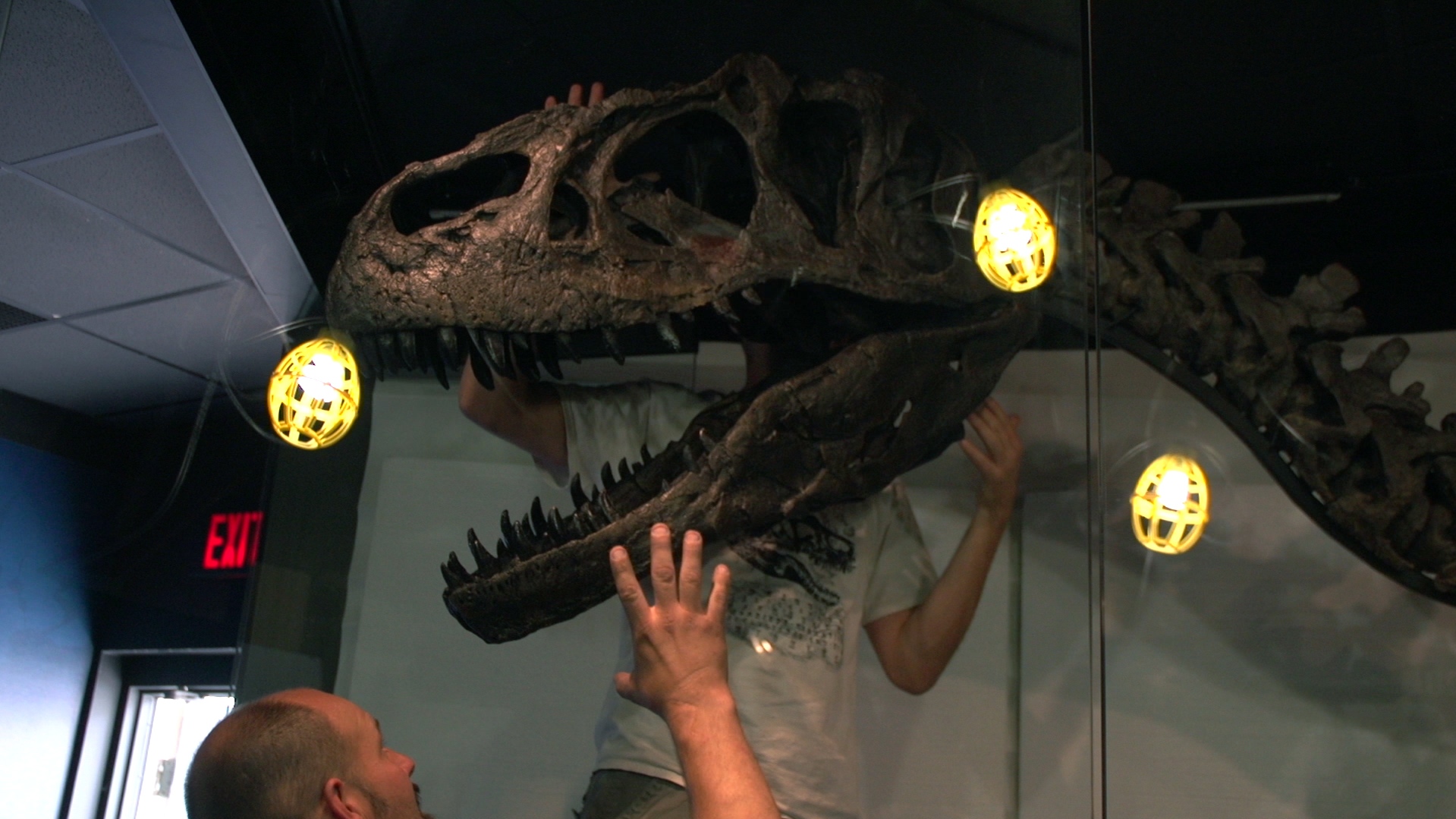
A 137 Films Production
Directed by Monica Long Ross and Clayton Brown
Produced by Amy Ellison, Monica Long Ross, and Clayton Brown
97 minutes, 2019
A documentary film about creationism, Noah's Ark, and America's troubled relationship with science.
A discussion will follow the film. Panelists include Director Clayton Brown; Dan Phelps of the Kentucky Paleontological Society (featured in the film); Megan Hoffman, Professor of Biology at Berea College; and Trent Garrison ,Geology Professor at Northern Kentucky University and Chair of KAS Advocacy & Education Committee.
ABSTRACT
Soil enzymes activities in the rhizosphere of field-grown tomato plants were used to monitor the impact of seven soil amendments (SM) and SM mixed with biochar on soil microbial activity before and 4 months after addition of amendments. The soil amendments were sewage sludge (SS), horse manure (HM), chicken manure (CM), vermicompost (worm castings), commercial inorganic fertilizer, commercial organic fertilizer, and native bare soil (used for comparison purposes). Each of the seven amendments was mixed with 10% (w/w) biochar to make total of 14 treatments. The results showed large differences in enzymes activities, secreted by soil microbes, before and after incorporation of soil amendments. Soil analysis revealed that urease activity increased 53% in HM amended soil and about 4 times in CM amended soil 4 months following treatment. CM amended with biochar increased urease activity by 11%. Similarly, significant increase in urease activity in all soil treatments, even in the no-mulch bare soil, were detected. Invertase activity increased significantly after the addition of all soil amendments. Organic manure treatments (SS, CM, HM, and vermicompost) enhanced soil biological activity (microbial biomass and release of urease, invertase, and phosphatase). Using organic manures rather than inorganic fertilizers in crop production is an affordable and more sustainable agricultural production systems.
soil health while increasing livestock production
Ewing, K. P., P. A. Gunter, A. M. P. Netthisinghe, H. O. Galloway
Cover crops have become an increasingly popular option for alleviating agronomic and environmental concerns, such as erosion. Dual utilization can increase forage efficiency and increase immediate economic return but understanding the impact on soil health may affect viability of this strategy. In a two-year study conducted in Bowling Green, Kentucky, soil health was analyzed comparing three treatments: grazed wheat (Triticum aestivum) to un-grazed wheat and tall fescue (Festuca arundinacea). Sixteen cow calf pairs were randomly allocated to grazed wheat or tall fescue for two weeks. Soil samples were analyzed following grazing to quantify soil physical and chemical parameters. Nitrogen (N) varied among all three treatments (P=0.03) and was greater in year 2 (2.21% vs. 4.11%; P=0.0001). Nitrate (NO3) and ammonia (NH4) concentrations varied between year at 4.40 ppm vs. 9.21 ppm (P=0.0001) and 19.17 ppm vs. 5.29 ppm (P=0.0001) respectively. Variance in organic matter (OM) was observed between the three treatments (P=0.0001) and year (25.74% vs. 30.12%; P=0.0001). Decreased ammonia levels in year 2 may be due to conversion to nitrates, which were significantly higher in the second year, while N fertilizer application may have contributed to overall increased N. Differences in OM could have been due to lack of residue in un-grazed wheat. Overall, minimal location x year interaction suggests that grazing had minor impact on soil health after one grazing period. Further research is required to thoroughly investigate the impact of cover crop grazing on soil health.
Most of the phosphorus (P) in feeds containing high inclusion levels of soy-protein feedstuffs occurs as phytic acid (PA), which is not digestible by fish. Supplementation of microbial phytase into soy-based formulations to degrade PA can increase P availability to fish and minimize P excretion to receiving waters. A twelve-week feeding trial is underway to evaluate the effects of supplementing phytase (PTS) in soy-protein-based diets on the growth performance and mineral composition of largemouth bass (LMB). A total of seven diets were formulated to contain 40% crude protein and 12% lipid and were amended as follows: the first diet (PTS-0) was not supplemented with phytase or inorganic P to serve as the negative control; the second diet (PTS-0 + IP) was identical to PTS-0 except that it was supplemented with inorganic P to meet LMB P requirements and serve as the positive control; the remaining five diets (PTS-250 to PTS-2000) were supplemented with a commercial phytase product (Natuphos, BASF, Ludwigshafen, Germany) to obtain final dietary phytase levels ranging from 250-2000 units/kg that were used to assess the effectiveness of the enzyme in increasing P availability by breaking down PA. Each diet is being fed twice daily (8:00 and 16:00) at apparent satiation to triplicate groups of 20 LMB (initial weight ~10.25g) stocked in 110-L aquaria operating as a recirculating aquaculture system. Results, including growth, survival, feed efficiency, and P retention in whole-fish, will be presented after the conclusion of the feeding trial.
Western Kentucky University spends $300,000 annually to transport trash to a landfill 80 miles away. Much of that waste is organic material. Recently, the Baker Arboretum constructed an in-vessel composter which consolidates food waste from select WKU dining locations, transforming it into compost for on-site use. This machine can process up to 330 pounds of food waste a day, and through the course of approximately a month, the material becomes nutrient-rich compost. This solution reduces environmental emissions, repurposes food waste, and lessens the amount of material we send to landfills. The operating budget for this system is funded by WKU's Resource Conservation Department, but is currently less cost-efficient than taking waste to a landfill. Our project takes an economic approach to this issue, focusing on the benefits and costs associated with this machine. To project the financial feasibility of composting, we will utilize investment analysis techniques such as payback period, return on investment, net present value, benefit-cost ratio, internal rate of return, and partial budgeting analysis. After developing an initial understanding of this system, we will look at the large-scale economics of a project, potentially incorporating the Warren County Public School System, Warren County Public Libraries, and the City of Bowling Green.
Composting has been around for centuries, yet we are just beginning to perfect in-vessel composting machines. The Baker Arboretum near Western Kentucky University hosts such a digester. Pre and post consumer food waste from restaurants on the campus of WKU is composted. However, the composer is a proprietary design and little research is available to understand and optimize its operation. In addition to food waste, sawdust is also added as a carbon source to optimize the C:N ratio of 30:1, increases temperatures, and decreases anaerobic conditions. Because of the vessel's closed format, moisture management has become very important to the operation. Our goal is to analyze and characterize the optimal parameters needed to efficiently produce quality compost. We will correlate inputs and variables to determine optimal ranges for microbial composition. We are monitoring input and output weights to understand mass loss. Temperatures are being monitored in five sections down the distance of the composter as well, to identify optimal those optimal areas between 130-160 degrees F. There has been great interest by municipalities and school systems in this pilot program and will base their decision to purchase, in part, on our data.
In this talk, I plan to present the facts on the controversy, and encourage the participants to form their own opinions. Even a debate here is welcome, but please keep it civil!
Methods: 21 healthy participants (9 female, 11 male; ages 18-58) performed five sessions; the initial session tested for basic anthropometric data: body composition, resting metabolic rate (RMR), height, body mass, and blood pressure. Participants then performed four 30 minute, low intensity, treadmill runs/walks. Fed conditions were comprised of participants consuming a shake equivalent to 25% of their individual daily needs one hour prior to testing. The fed conditions were modified to produce the varying fed states: high carbohydrate (75% carbohydrates), high fat (60% fats), and the mixed meal which contained the proper proportion of carbohydrates, proteins, and fats (50%, 30%, and 20% respectively). For the fasted session, subjects were asked to fast for a minimum of 10 hours prior to the test.
Results: The average RER of the fasted, mixed meal, and high fat meals were 0.802, 0.861, and 0.817 respectively. The standard deviations of the previously stated variables were ± 0.092, 0.087, and 0.083. There was a significant difference between the RER values for the fasted and mixed meal states (p= 0.009). However, there was no significant difference between the fasted and high fat conditions (p=1.000) nor the mixed meal and high fat states (p=0.089).
Conclusion: More fat is burned during a fasted state during low intensity cardiovascular exercise compared to a fed state.
The object of this study is to use the HPV16 E6 biomarker to develop a cohort of individuals who are at highest risk of HPV-OPC. We will capitalize on the pre-existing infrastructure at Vanderbilt to test residual blood samples from healthy men aged 45-70 without diagnosed cancer for the presence of HPV16 E6 antibodies to estimate the seroprevalence of HPV16. OPC.
Victoria Pham, Math & Economics, Senior, Berea College
1) The objectives of this research were: 1) to identify major causes for cervical and lumbar fractures and 2) association of risk factors with both type of fractures. Evaluation of best treatment approaches in cervical and lumber fractures
Introduction: There are about 6.8 million vertebral fractures occurring each year in the U.S. Incidence of vertebral fractures differ with the age. The age of vertebral sufferer impacts with the intervention and rehabilitation process. Therefore, it is important to identify age related causative factors of vertebral fractures in the population.
Methods: This presentation emerged from my internship at the Hospital of University of Pennsylvania. This study uses national data from National Electronic Injury Surveillance System (NEISS) 2009 to 2018 available in public domain. It is a cross-sectional research design that attempted to identify major causes of neck and lumber injuries and their association.
Results: Causes of neck and lumber fracture were not found significantly different (x2 = 253.00, df = 255, p=0.524) among people from 0 to 19 years of age. Our results indicates that prevention strategies developed to address all types of risk factors can reduce occurrence in both types of fractures.
Conclusions: Findings of this study suggests that different risk factors play role in neck and lumber injuries at different age. Public health preventive strategies targeted to the specific causes of injuries can reduce burden of neck and lumber fracture in the population.
Victoria Pham, Math & Economics, Senior, Berea College
1) The objectives of this research were: 1) to identify major causes for cervical and lumbar fractures and 2) association of risk factors with both type of fractures. Evaluation of best treatment approaches in cervical and lumber fractures
Introduction: There are about 6.8 million vertebral fractures occurring each year in the U.S. Incidence of vertebral fractures differ with the age. The age of vertebral sufferer impacts with the intervention and rehabilitation process. Therefore, it is important to identify age related causative factors of vertebral fractures in the population.
Methods: This presentation emerged from my internship at the Hospital of University of Pennsylvania. This study uses national data from National Electronic Injury Surveillance System (NEISS) 2009 to 2018 available in public domain. It is a cross-sectional research design that attempted to identify major causes of neck and lumber injuries and their association.
Results: Causes of neck and lumber fracture were not found significantly different (x2 = 253.00, df = 255, p=0.524) among people from 0 to 19 years of age. Our results indicates that prevention strategies developed to address all types of risk factors can reduce occurrence in both types of fractures.
Conclusions: Findings of this study suggests that different risk factors play role in neck and lumber injuries at different age. Public health preventive strategies targeted to the specific causes of injuries can reduce burden of neck and lumber fracture in the population.
Here, we present an application of machine learning in rock facies prediction based on limited core data from the Umiat Oil Field of Alaska. First, we identified five rock facies within the Lower Grandstand Formation using core samples and mineralogical data from the Umiat 18 well. Next we applied machine learning algorithms (ascendant hierarchical clustering, self-organizing maps, artificial neural network and multi-resolution graph based clustering) to available wireline log data to build our models trained with core-driven information. These models were then individually applied to nearby wells, Umiat 23H and SeaBee-1 for predicting similar rock facies at different depths.
To begin to address this broad question, I am genetically engineering a circularized version of chromosome XVI in the yeast Saccharomyces cerevisiae. The method involves inserting DNA cassettes containing selectable markers at both ends of chromosome XVI, and then selecting for a recombination event between the cassettes that causes circularization. I have successfully confirmed integration of the DNA cassettes in both arms of chromosome XVI. I am currently attempting to select for the recombination event that will cause circularization. In an effort to increase recombination efficiency we have recently designed a CRISPR gDNA that will direct DNA double-strand breaks within our DNA cassettes. Once yeast with a circular chromosome XVI are confirmed, we will assess their relative fitness. This experimental approach may eventually shed light on the evolution of linear chromosomes in eukaryotes.
Usman Salim1,2, Hasan Salim1,2, Anas Gondal1,2, Dr. Ajay Srivastava2
1: Gatton Academy of Math and Science, WKU, Bowling Green, KY
2: Department of Biology and Biotechnology Center, WKU, Bowling Green, KY
Drosophila melanogaster is a commonly used organism in biological research. Their Air Sac Primordia (ASP) is analogous to human lungs but is studied for its behavioral similarities to tumors. This is due to the ASP metastasizing to the Wing Imaginal Disk (WID) in a manner like that of tumors. One gene found in Drosophila codes for a V-ATPase which was believed to influence the growth and development of the ASP. The V-ATPase is a vacuolar proton pump that plays a large array of roles from regulating the pH of cells internal space, to regulating endocytosis, to processing proteins and degradation. In insects, the V-ATPase are important in establishing a membrane potential to drive K+ secretion. It has also been found to influence tracheal branching. Using RNA interference, the gene for the V-ATPase was knocked down. Data from these experiments will be presented and their significance will be discussed.
Elisha VanZant1,2, Dr. Ajay Srivastava2
1: Gatton Academy of Mathematics and Science
2: Western Kentucky University Department of Biology and Biotechnology Center
The Air Sac Primordia (ASP) in Drosophila melanogaster develops outside of the Drosophila's Wing Imaginal Disc (WID) and grows into and within it. This invasive behavior is similar to the behavior of developing metastatic tumors. Genes involved in Basement Membrane remodeling have been found to influence tumor metastasis and ASP invasion of the Wing Imaginal Disc. By utilizing protein traps and finding the genes responsible for Basement Membrane degradation in Drosophila, the genes responsible for tumor metastasis can be identified. In this study, thirty lines of Drosophila were dissected and screened for positive ASP expression in the Wing Imaginal Disc. Out of these, five lines appear to have positive expression in the Wing Imaginal Disc and one appears to have positive ASP expression. This will be followed up by knock down of the gene with positive ASP expression to note the effects on ASP invasion when the gene is not present as well as the screening of several more Drosophila stocks. The genes identified with positive ASP expression could possibly parallel genes found in tumor invasion in humans. This result will provide further reason for this gene to be studied and analyzed in the context of human cancer.
gene was shown to overexpress in patients with diverse diseases such as breast, lung,
and skin cancer. A comprehensive bioinformatics based phylogenetic analysis would
better elucidate the role of this gene in humans and would help establish a molecular
basis for cancer disease mechanisms.
Phylogenetic analysis of the DAXX gene would help in discovering the evolutionary
origins of this gene and help identify a model organism that can prove to be a valuable
experimental tool to understand the function and impact of this gene on an organism.
Using a variety of bioinformatics tools, we found that the closest related ancestral model
experimental organism to humans is the lab mouse, Mus musculus. Further, Danio rerio
(zebrafish) and Drosophila melanogaster (fruit fly) were also found to contain this gene
with 67% and 45% similarity to humans, respectively. This finding provides an
opportunity to study this gene's function and biology in a tractable organism. Preliminary
research in one of these model organisms could prove to be valuable and low-cost
experimental tools in understanding the molecular basis of cancer and the related
findings could be extrapolated to understand the functional aspects of DAXX in related
diseases in humans.
Previous studies have shown an overexpression of the luteinizing hormone-releasing hormone (LHRH) receptor on A2780 and A2780-cis cells. We have designed and synthesized a selective chemotherapeutic agent, Pt-Mal-LHRH, to target this receptor. Pt-Mal-LHRH attaches the LHRH peptide to cisplatin to selectively target and deliver cisplatin to the cancer cells. Platinum is used in common chemotherapeutic agents such as cisplatin and carboplatin, however, both compounds elicit detrimental side effects without targeting ovarian cancers. Further, cisplatin has high rate of resistance formation in patients.
To address whether Pt-Mal-LHRH is more selective agent than carboplatin and cisplatin, a drug uptake assay was conducted. The assay screened for platinum concentrations within the cells to show disruption and cessation of cancer growth. This assay was completed using both the A2780 and A2780-cis line of cells. The results of the assay suggest that there is a significant increase in uptake of Pt-Mal-LHRH in comparison to carboplatin in both the A2780 and A2780-cis cells. The assay further suggests that in the A2780-cis line there is a significant increase in uptake of Pt-Mal-LHRH in comparison to cisplatin.
Objective: To produce ML-II in Nicotiana benthamiana, extract and purify the protein, and test its anticancer activity in different malignant cell lines.
Methods: By using the GENEWARE technology, the ML-II protein was transiently expressed in Nicotiana benthamiana plants. Infectious tobacco mosaic virus (TMV) RNA transcripts were generated with the mMessage mMachine T7 kit and used to infect the plants. After plant infection, ML-II levels were assessed at different time points to determine the optimal time of protein expression. ML-II was detected and quantitated by SDS-PAGE, Western blot, and ELISA. To purify the protein from the plant extracts, fast protein liquid chromatography (FPLC) was performed on an affinity galactose agarose resin column. The MTS cell viability assay was performed to assess breast cancer MDA-MB-231 and lung cancer H460 and A549 cells after 72 hours of treatment with dilutions of ML-II starting at 10μg/mL. Microscopy was used to assess morphological changes.
Results: ML-II was successfully expressed in Nicotiana benthamiana, with the highest expression level obtained at 15 days post infection (30 mg/kg fresh tissue weight). In addition, ML-II bound to asialofetuin and showed anticancer activity against H460 cells with an EC50 of 1.8μg/mL. The other two cancer cell lines showed no susceptibility to ML-II in the MTS assay; however, cytotoxicity was observed by microscopy.
Conclusion: These findings confirm that ML-II can potentially be used for cancer treatment in the future and deserves further investigation.
C. elegans has six chromosomes, five autosomes, and an X chromosome. We crossed the suppressed pam-1; spam-1 double mutant into two different, marked strains, MT464 and MT3751. MT464 possesses marked, visible phenotypes associated with chromosomes IV, V and X. MT3751 possesses marked, visible phenotypes associated with chromosomes I, II, and III. By observing the ratios of suppressed vs. non-suppressed F2 animals segregating with each visible marker, we will be able to map the spam-1 locus to a specific chromosome. Our goal is to reduce the location of spam-1 to a tightly defined region as to enable the sequencing of candidate genes.
We found that glis3 is expressed in embryos between 12-24 hpf when the expression was mostly limited to the brain and pronephros. By 72 hpf, expression was evident within the pancreas suggesting a possible role in secondary islet generation or beta cell mass expansion. Morpholino knockdown of glis3 in zebrafish resulted fish that had a more restricted area of insulin expression and a disruption of the normal islet architecture suggesting that glis3 is not required for β cell specification in zebrafish, per se, but may have roles in subsequent β cell expansion and distribution. Collectively, these results indicate that glis3 is important in pancreatic development in zebrafish and may provide valuable insight into human pancreas development and the etiology of diabetes.
Running Buffalo Clover, Trifolium stoloniferum, is a perennial plant native to Eastern and Midwestern states that reproduces asexually by rooting new ramets from extended stolons, as well as through fruit production. Trifolium stoloniferum is most common in disturbed forests with partial shade. It is known for its association with buffalo once native to the same areas, but now extinct. It is hypothesized that the clover lived in areas associated with buffalo because buffalo provided intermediate disturbance that suppressed competitors and nitrogen and added phosphorus via feces. It is likely that the association with buffalo is why that T. stoloniferum lacks rhizobia in its roots. Specifically, associations with arbuscular mycorrhizal fungi (AMF) may take on a larger role in nutrient acquisition for T. stoloniferum due to the loss of nitrogen fixing associations. These fungal symbionts penetrate the roots of T. stoloniferum and form arbuscules, which house haustorial organs for nutrient exchange. We collected and stained root samples from plants in three restoration populations of T. stoloniferum at Taylor Fork Ecological Area on the campus of Eastern Kentucky University in Richmond, KY in July 2019. Root sampling and staining were performed in order to determine if there would be a difference of AMF colonization in original and daughter plants, as well as plants known to be from the same genet. There was no significant relationship between original plant and daughter plant colonization or when comparing plots, but preliminary data suggests daughter plants had more AMF abundance than original plants.
In this work, I prove that Neptune is responsible for the instability of Uranian trojan orbits by causing the Uranian trojans to leak out of tadpole orbits into more unstable horseshoe orbits.
Support for the project was provided by the Department of Physics and Astronomy and the Ogden College, WKU
Special thanks to Western Kentucky University for providing funds through the FUSE Award #19-FA253.
Semi-autonomous driving refers to a driving condition where the computer controls the car, but a human driver is still required to be attentive to the road ahead (SAE International, 2018). The current study investigated the effects of computer generated audio learning in a semi-autonomous driving situation.
Description
Vehicle automation can be classified into different levels, from Level 0 with no automation, to Level 5 with full automation (SAE International, 2018). At Level 0, the human driver is fully responsible for steering, acceleration, deceleration, and braking. Level 1 is similar to the cruise control system in most modern cars, with computer assisted acceleration, deceleration, and even braking. Levels 2 and 3 currently exist in certain high-end vehicles, with computer steering assistance added to the traditional cruise control. Drivers, especially commuter students, might start to take advantage of Levels 2 and 3 vehicle automation as they become more prevalent. The current study investigated attention and learning outcome in a simulated driving situation, where the driver had to learn from a computer generated audio text but also monitor and respond to warning messages in a simulated Level 2 autonomous driving situation. Results indicated that drivers would experience higher levels of mental workload and have impaired learning performance in a Level 2 autonomous driving situation. Findings from the current study could provide important safety and learning recommendations as autonomous driving becomes more prevalent.
The most recent census on drug addiction shows that at least 24 million Americans (9.4%) have used illicit drugs in the preceding month. Of these, approximately 19.6 million have, or have had, a substance abuse disorder in the preceding year (NorthPoint Staff, 2017). Addiction is a complex condition, a brain disease that is manifested by compulsive substance use despite harmful consequence (APA, 2019). Does marijuana fall under this spectrum? Our research was completed through EKU libraries' PsychInfo using key terms such as marijuana, addiction, heroin, white matter, brain activity, and functional/static brain imaging. The research articles provided peer-reviewed brain imaging comparisons of marijuana and heroin usage effects. The participants used were screened beforehand to eliminate any outliers in brain composition. Our findings concluded similar effects on brain activity through marijuana and heroin usage. While marijuana does not meet the 'criteria' placed upon addictive illicit drugs, this is important information due to the drug crises in the United States and how marijuana can be hypothesized within this information.
We conducted a meta-analysis on how strong the relationship between distractions is and driving performance. There are many factors to consider when thinking about distracted driving and its outcomes. This meta-analysis includes three of the top disablers for safe driving. We compared drunk driving, high driving, and texting while driving. We used five different studies that included the impairments and statistics of how it affected you're driving. We came to a conclusion of an overall rate of distraction is .44 which is moderate. We learned that drinking and driving impairs your driving the most out of the three. For the weakest marijuana, our results gave us the sum of .22. The next in line in the middle is texting which was relatively close to alcohol consumption which is .31 and alcohol stood at .38.
We all know someone that has been affected by a distracted driver. According to the Center for Disease Control, every day, there are approximately 9 people killed and more than 1,000 injured in car accidents that are reported to involve a distracted driver. Our research question is 'What impact does texting, alcohol, and marijuana have on driving?'. We found five research articles from PsycInfo that provided data about how bad distracted driving actually is. The overall weighted average effect size was computed from the effect size of each study. The overall effect sizes were moderate for alcohol, strong for texting, and very weak for marijuana. We concluded that smoking marijuana had no effect on driving, while texting and drinking alcohol did.
Atmospheric boundary layer (ABL) heights separate turbulently mixed air and pollutants emitted at the ground from the free troposphere above and are an important parameter in numerical weather prediction and air pollution dispersion models. Discerning the ABL height over mountainous terrain has historically been difficult because of, for example, complex interactions with upper level winds, venting of humidity and aerosols into the free troposphere, and large spatiotemporal variability. Mountain ABL's can closely follow the terrain, be flat, or be shallower than surrounding valleys depending on the time of day, season, and synoptic conditions. To determine the extent to which the ABL heights follow terrain, water vapor, potential temperature, and turbulence collected by NASA aircraft during accents and descents over mountains across Central and Southern California during the 2009-2018 Student Airborne Research Programs (SARP) were plotted versus altitude. United States Geological Survey elevation data were spatially joined with the aircraft data in a geographic information system so the topography underlying the aircraft vertical profiles could be determined. North American Regional Reanalysis data were used to evaluate the synoptic weather conditions influencing ABL heights. Vertical profiles created by the aircraft ascending and descending over the southern Sierra Nevada and Coastal Ranges indicate that ABL heights follow the topography of these areas during ridging synoptic patterns, being higher over ridges and lower over valleys. This characterization of ABL behavior can then be used to improve numerical weather prediction and discern whether mountaintop greenhouse gas monitoring stations are sampling the free troposphere.
This study also seeks to understand how residents and non-profits feel about strategies that build community through the use of food. Local non-profits were asked from their perspective about meaningful research regarding food insecurity, this alongside interviews that have been conducted with residents have suggested overlapping themes of topics that have been commonly identified as barriers to food insecurity or areas that need additional research. This approach helps bridge the gap between local universities and neighborhoods in the community who have expressed frustration with being overly researched by these institutions.
 In this hands-on workshop, participants will learn and practice one of these fascinating applications of chemistry in art silk scarf dyeing, brass medallion etching, and Prussian blue pigment synthesis! Workshop participants will get to try each activity and leave with both the final product, as well as handouts and instructors notes for incorporating these artful applications in a chemistry course. Please bring a thumbdrive for an electronic version of materials. Presented by Mary Robert Garrett of Berea College.
In this hands-on workshop, participants will learn and practice one of these fascinating applications of chemistry in art silk scarf dyeing, brass medallion etching, and Prussian blue pigment synthesis! Workshop participants will get to try each activity and leave with both the final product, as well as handouts and instructors notes for incorporating these artful applications in a chemistry course. Please bring a thumbdrive for an electronic version of materials. Presented by Mary Robert Garrett of Berea College.
President Lyle D. Roelofs
Dean of Faculty Matt Saderholm
LaTrice Montgomery

Assistant Professor and licensed Clinical Psychologist University of Cincinnati College of Medicine
Department of Psychiatry and Behavioral Neuroscience, Addiction Sciences Division
LaTrice Montgomery is an Assistant Professor and licensed Clinical Psychologist in the Addiction Sciences Division of the Department of Psychiatry and Behavioral Neuroscience at the University of Cincinnati College of Medicine. She received her B.A. degree in Psychology from Berea College and both her M.A. and Ph.D. in Clinical Psychology from the University of Cincinnati. She completed her National Institute on Drug Abuse sponsored clinical internship at the Yale University School of Medicine in the Division of Substance Abuse. Dr. Montgomery's research interests include marijuana and tobacco co-use (especially via blunts) and medical marijuana. LaTrice has presented her award-winning work at several local, regional and national conferences. In addition, LaTrice's work has been published in top-tier journals, including Drug and Alcohol Dependence and the Journal of Consulting and Clinical Psychology. She recently received a career development award (K23) from the National Institute on Drug Abuse to develop and evaluate a Twitter-based intervention for young adult blunt smokers.
- Governing Board Election results will be announced
- Science Education & Outreach Award winner Lenny Demoranville will share stories of taking science outside the confines of the college classroom.
- We’ll discuss ideas for the digital evolution of the Journal of the Kentucky Academy of Science
- The KAS Governing Board & staff will share reports and updates
The katydid genus Neoconocephalus is parasitized by the eavesdropping tachinid fly Ormia lineifrons. This parasitism exerts strong selective pressure on the host because infested katydids die within two weeks, reducing their reproductive life span. The natural history of this parasitoid/host arms race is poorly understood and the focus of this study. More specifically, we present data on which Neoconocephalus species in Kentucky are used as hosts, and compare their parasitism rates, parasitoid infection numbers and developmental success to better understand the selective pressure exerted on each host.
Four of the six Neoconocephalus species collected in Kentucky were parasitized by O. lineifrons. The parasitism rates of each species varied, but the effects of parasitism were strongest in N. triops and N. velox. The average number of parasitoid larvae placed on the host ranged from one to three. The pupal weight of the parasitoids was negatively correlated with the number of larvae harbored by the host in all species. The developmental success rate to adult flies ranged from 34% to 71% among the four species. We discuss potential evolutionary ramification of our findings for the parasitoid and the hosts.
2014). In this research project, we observed the behaviors and preferences of different avian species who inhabit the area around the bird feeders at John James Audubon State Park in Henderson, Kentucky. Using 30-minute video recordings from two separate feeders in different locations (sunny and shady), we were able to identify 12 different species with the assistance of Birds of Kentucky: A Field Guide by Stan Tekelo. The information provided by the recordings allowed us to estimate the general population, as well as each species' population. A t-test revealed a feeder location preference, affected by temperature, during the fall semester (0.021), but not during the spring semester (0.186). The species preferred the shaded feeder location during cooler temperatures; however, once the temperature became too cold, especially during the winter months, the birds would feed from either location. This result is likely due to the low food availability during this time. Nevertheless, the results collected during the fall semester have allowed the staff at the Audubon State Park to expand their knowledge about the avian species populating the area and provide better conservation efforts in the hopes of bringing more diverse species to the area for public enjoyment.
Proterometra macrostoma is a digenetic trematode which is widely distributed in the eastern United States. The objectives of this study were to assess: (1) survival of intramolluscan stages (i.e., rediae and cercariae) of this trematode at a winter temperature and (2) whether or not cercarial development inside the redia ceases at or below its MDTT (minimum development temperature threshold; 10-12° C). Naturally infected snails were collected from North Elkhorn Creek. Baseline cercarial emergence was recorded over 7 days at 20° C for three replicates of 19 infected snails each. Replicates were then maintained at 7.5° C for 28 days followed by a post-cold treatment analysis of cercarial emergence over 7 days at 20° C. Approximately 95% (52/55) of infected snails shed cercariae following both the pre- and post-cold treatments, and significantly more cercariae were released/snail/7days following the post-cold treatment compared to the pre-cold treatment in two of the three replicates. No significant differences were found in the average number of the four cercarial stages within rediae pre- vs. post-cold treatment. These results suggest that during winter months there is no loss of infection with some further maturation of the Stage IV cercariae as indicated by our cercarial emergence data and not detectable by our staging criteria
Ethanol fermentation is a popular metabolism exploited by industries due to the consumers' need for alcoholic beverages or biofuel. There are previous studies showing the main contaminant in biofuel fermentation is Lactobacillus. Similar but slightly different industrial processes in the production of beverages may lead to different contaminants. This goal of this study was to use a culture-based method of identification of the bacterial contaminants in the spirit fermenter tanks. Homofermentative Lactobacillus was identified based on culture technique. 16S rRNA gene sequencing for species identification supported the culture-based methods. Based on the process used for beverage production, it is likely this contaminant was present in the milled grain in the fermented mixture. This data reveals possibilities to prevent or treat the problem without the use of antibiotics, a common temporary relief, that have been shown to add to the growing problem of antibiotic resistance. Finding the cause of the contamination can be more economically feasible from a quality assurance stance as well. Enacting more specific cleaning protocol at the point of contamination is more cost-efficient than continuously upgrading the type of antibiotic used.
The goal of this project is to identify the function of the P protein in HMPV viral replication and, ultimately, find a way to inhibit replication and viral spread.
Abstract:Reprogramming somatic cells into induced pluripotent stem cells (iPSCs) can be achieved through ectopic expression of the OCT4, KLF4, SOX2 and cMYC transcription factors (Yamanaka factors). This process provides an unlimited supply of cells with embryonic stem cell (ESC)-like properties, without the ethical concerns associated with the destruction of a human embryo. The resulting iPSCs have proven to be a promising tool to study human development and disease. Kogut et al. have optimized a protocol to generate iPSCs with the development of a high-efficiency RNA-based reprogramming method. Pluripotency refers to the ability of a cell to differentiate into the three primary germ layers of human embryo development- endoderm, mesoderm, and ectoderm. The objective of my research was to validate the differentiation capacity of iPSCs into these three germ layers using a commercially available trilineage differentiation kit. An iPS cell line was cultured, collected, and seeded into germ layer-specific medium provided by the kit. Cells were cultured and allowed to differentiate into endoderm, mesoderm, and ectoderm in their respective medium over a number of days. Immunofluorescent staining using lineage-specific markers was performed, demonstrating successful differentiation of iPSCs into the endoderm, mesoderm, and ectoderm germ layers.
S. cerevisiae contains two genes, SAM1 and SAM2, encoding the enzyme that catalyzes the formation of S-Adenosyl-methionine (AdoMet). AdoMet is a coenzyme involved in methylation reactions within the cell. Previous work from our group has shown that sam1 and sam2 mutations differentially affect genome stability. We used eight yeast strains missing the DNA damage checkpoint gene rad9 and various combinations of mutations of the sam1 and sam2 genes to assay for additional phenotypic differences in these cells. A Phenotypic Microarray assessed the growth difference between the control and mutants in 1440 different chemical/nutrient environments. As genome instability is a common phenotype in cancer development, we included the rad9 gene deficiency, and thus the faulty DNA damage checkpoint, to assess the combinatorial effect of these pathway mutations. With seven mutant strain growth patterns compared to the control, 10,000 conditions/mutation combinations were assessed and 1661 were found with altered growth. This represents 331 different chemicals with 83 different modes of action. Our current focus is aimed at evaluating the changes resulting from the full loss of rad9 and each of the SAM genes: rad9ÃÆ'Ž'/rad9ÃÆ'Ž' sam1ÃÆ'Ž'/sam1ÃÆ'Ž' and rad9ÃÆ'Ž'/rad9ÃÆ'Ž' sam2ÃÆ'Ž'/sam2ÃÆ'Ž' strains. This will allow us to gauge the impact of the combinations of the mutations on SAM1 and SAM2 separately. Our ultimate goal will be linking the observed alterations in growth to causative pathways related to AdoMet to understand a larger breadth of changes due to mutations resulting in the loss of these vital AdoMet synthetases.
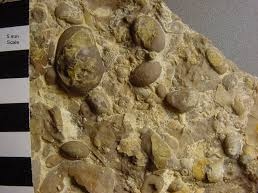

After our Saturday sessions are over at 3:30, we're going to the forest to enjoy the last hours of Daylight Saving time! Sunset is 6:43pm.
Meet at the Forestry Center parking lot, 2047 Big Hill Rd. Berea, KY 40403. You can join a guided hike at the Berea College Forest with the Forestry Center staff. There are various trail options here including the famous Pinnacles trail. Dr. Ralph Thompson will also lead a hike here (There’s not enough time for a hike to Anglin Falls, but hike with Ralph and ask him all about it!)
Dress for the weather, bring some water, take some photos (#TheSpiritOfKAS) and have fun!
5-8pm on Saturday: If you have little hikers with you, there’s also a family-oriented Tinkergarten Lantern Walk. Meet at the Berea Forestry Outreach Center 2047 Big Hill Rd. Berea, KY 40403
Join SAF Buses that will arrive in Berea around 10:00. $25, by Pre-registration.
Social media Photo contest
Capture YOUR experience of the KAS Annual meeting and share it using #TheSpiritOfKAS
Post your photos by 8pm Sunday Nov 3. Contest rules are at www.kyscience.org
KAS Twitter: @Kyscientists
KAS Instagram: kentuckyscience
KAS Facebook: Kentucky Academy of Science
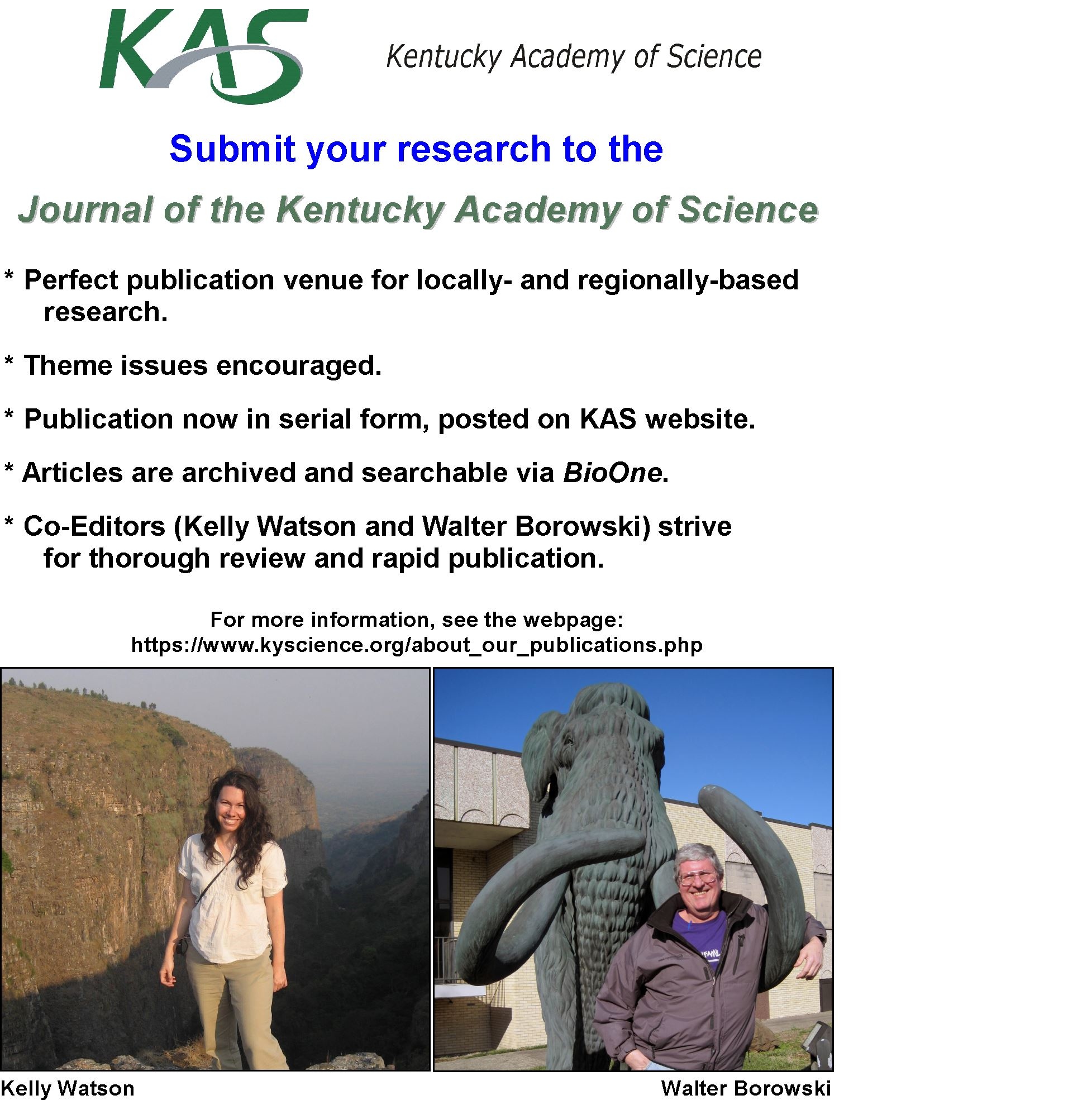
2025
